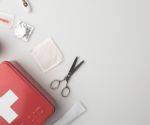Advertisement
- Check the person’s head by examining the scalp, face, ears, mouth and nose.
- Look for cuts, bruises, bumps or depressions. Think of how the body usually looks. If you are unsure if a body part or limb looks injured, check it against the opposite limb or the other side of the body.
- Watch for changes in consciousness. Notice if the person is drowsy, confused or is not alert.
- Look for changes in the person’s breathing. A healthy person breathes easily, quietly, regularly and without discomfort or pain. Young children and infants generally breathe faster than adults. Breathing that is not normal includes noisy breathing, such as gasping for air; rasping, gurgling or whistling sounds; breathing that is unusually fast or slow; and breathing that is painful.
- Notice how the skin looks and feels. Skin can provide clues that a person is injured or ill. Feel the person’s forehead with the back of your hand to determine if the skin feels unusually damp, dry, cool or hot. Note if it is red, pale or ashen.
- Look over the body. Ask again about any areas that hurt. Ask the person to move each part of the body that does not hurt. Ask the person to gently move his or her head from side to side.
- Check the shoulders by asking the person to shrug them.
- Check the chest and abdomen by asking the person to take a deep breath.
- Ask the person to move his or her fingers, hands and arms; and then the toes, legs and hips in the same way.
- Watch the person’s face and listen for signals of discomfort or pain as you check for injuries.

Continue Learning about First Aid, Safety & Preparedness
Important: This content reflects information from various individuals and organizations and may offer alternative or opposing points of view. It should not be used for medical advice, diagnosis or treatment. As always, you should consult with your healthcare provider about your specific health needs.










